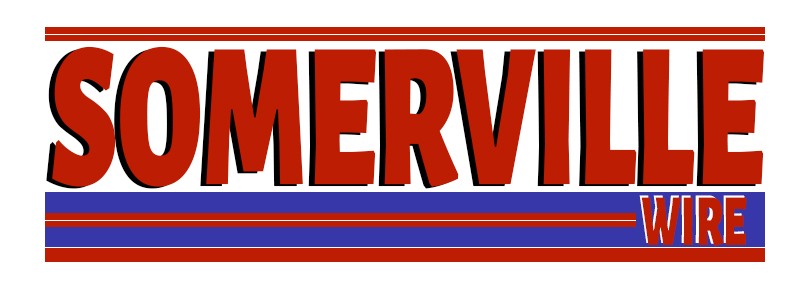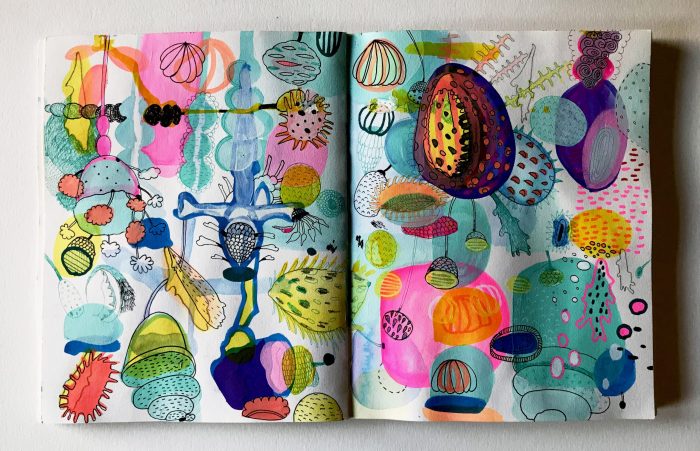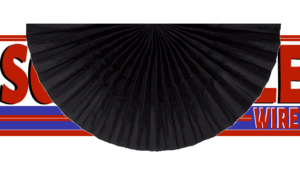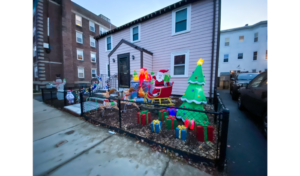The painter and printmaker’s work can be seen at the Inside Out Gallery
(Somerville Wire) – Boriana Kantcheva is a Boston-based creator whose exhibit “Earthly Delights” is currently being featured in the Davis Square CVS window. Her work is whimsical and heavily inspired by the beauty found in nature. Having grown up in Bulgaria, Kantcheva immigrated to the United States and has been living in Massachusetts for over 20 years. I asked her about some of her favorite pieces and how she reconciles the different identities that she relates to.
Your work as a painter and printmaker often draws from the natural world: birds, patterns, things found in the forest. Could you explain what these elements mean to you and how they are reflected in your art?
The natural world is the inspiration behind a significant number of my paintings and prints. I think the fascination with the nature started in my childhood. Growing up in my grandparents’ house, I was lucky enough to have access to a small but magical garden. It was tiny and full of life—flowers, vegetables, birds, and the occasional stray cat. With time my memories changed. The garden transformed into a mythical place. It became central in my personal narrative, a place of exploration, play, excitement, and safety. When I think of the place now, I remember the birds—swallows that nested in the same spot every year, tiny brown and gray owls on the roofs at twilight, crows, sparrows and my pet parakeets. Their lives integrated into the fabric of daily life. I recall the rose bushes, the massive hydrangeas and a pumpkin patch. I often use birds, animals, and plants in my work to create different narratives that explore themes of memories, impermanence, loss, joy, and fragility. I am fascinated by the complexity of the natural world and afraid of the damage done to it by a variety of human activities.
How did you find the inspiration for your show “Earthly Delights,” now on display at the Inside Out Gallery at the Davis Square CVS?
“Earthly Delights” came about as an invitation from Heather Balchunas from the Somerville Arts Council. I really liked the idea of showing work in a non-traditional space like the CVS windows. I initially wanted to exhibit only my prints, but Heather suggested showing my sketchbooks as well. In a sense, each window became a separate exhibit. I have never really showed my sketchbooks outside of a class setting. To me they are like diaries. They focus on process and experimentation. Once the sketchbooks were installed and some of the pages blown up, I enjoyed seeing them together. I think people are generally interested in seeing “behind the scenes” so to speak, rather than always seeing the finished work. I like that the sketchbooks with their messy, experimental pages are juxtaposed with the so-called “finished” pieces. Even though both windows show different kinds of work, they are related conceptually. Both explore similar ideas of flora and fauna and both bodies of work have a strong affinity to storytelling.
How would you describe some of your favorite pieces, and what was the process of creating them like?
One of my favorite pieces is a print titled “Owl / Garden,” a two plate etching with monotype. For people that are not familiar with printmaking, an etching is usually done by using a metal plate, in my case copper plates. The copper plate is covered with a tar-like substance called ground; then the image is drawn in the ground using an etching needle and put in ferric chloride. The ferric chloride etches the image into the copper. Once the etch is complete, the plate is cleared of the ground, and ink is pushed into the lines and printed with the help of a press that has not changed much in the last few hundred years. It is an archaic process and also labor intensive. I fell in love with it when I was in my second year of college, and I am so lucky that I can continue making prints right here in Somerville in a professional print studio called Mixit. I like etching because it creates beautiful, crisp lines, aquatint washes, and I also like the slow, sometimes unpredictable results. There is something really beautiful about handmade prints. They are imperfect. The copper plate retains the memory of the hand-made marks, and sometimes the accidents are the best part of the print.
You are originally from Bulgaria but have lived in the Boston area for over 20 years. What was it like to come to Massachusetts, and could you share a bit about your immigration story?
I was born in a small, sleepy town in the north part of Bulgaria. I grew up in what at the time was referred to as the Eastern bloc. My childhood was spent behind the “iron curtain,” and looking back, it seems very distant and dream-like. There was limited contact with the world that existed outside of the country’s borders, but I had good books to take me places and few, trusted childhood friends to share my imagined adventures.
I moved to the US right after high school, and my life has changed significantly. Ever since, I have tried to reconcile the past and the present. There is a sense of duality in my life–the pull of the old world with the excitement of the new. I imagine this is the experience of countless immigrants, and it is in no way unique from the thousands of people who began a new life in a different place. One of the things that I was really grateful for was being able to attend wonderful art schools in Boston. I met amazing artists, learned from good faculty, and I am continuously grateful to be a part of the local artistic community.
You have done some work teaching, as well. What do you enjoy about leading classes, and what do you hope to impart to your students?
I enjoy teaching for lots of reasons. One is that I am so excited when people want to learn how to paint, draw, or print. I often have students that are new to art or have not done anything creative in sometime. It is wonderful to see how eager they are to learn, to explore new materials, and just to make. In my classes, especially in a class titled “Develop Your Sketchbook,” I usually tell my students to let go of preconceived notions, to allow themselves to create, to be messy, and not to strive for perfection. Also, to begin, no matter the skill level or knowledge. Sometimes that first step is the hardest. I believe everyone can be creative and able to learn in a supportive atmosphere. I strive to provide that kind of support along with instruction in all of my classes.
This article is syndicated by the Somerville Wire municipal news service of the Somerville News Garden project of the Boston Institute for Nonprofit Journalism.
All Somerville Wire articles may be republished by community news outlets free of charge with permission and by larger commercial news outlets for a fee. Republication requests and all other inquiries should be directed to somervillewire@binjonline.org. Somerville Wire articles are also syndicated by BINJ’s MassWire state news service at masswire.news.
SUBSCRIBE TO THE FREE SOMERVILLE WIRE EMAIL NEWSLETTER: https://eepurl.com/hpBYPv
Check out all our social media here: https://linktr.ee/SomervilleWire.
Shira Laucharoen is assistant director of the Boston Institute for Nonprofit Journalism and assistant editor and staff reporter of the Somerville Wire.





